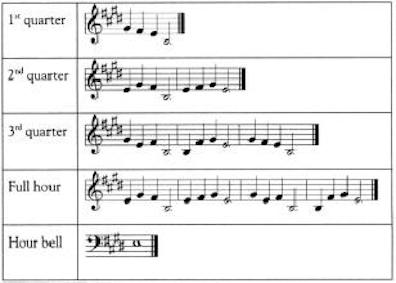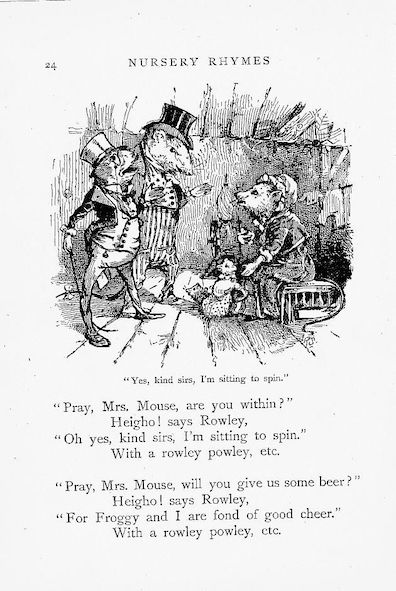At the end of Telemachus Stephen recalls words from
the prayer for the
dying in a peculiar way, clipping three phrases from the
longer text: "Liliata rutilantium. / Turma
circumdet. / Iubilantium
te virginum." At the end of Calypso Bloom
does something similar, repeating a phrase three times on
separate lines of the novel's text: "Heigho!
Heigho! / Heigho! Heigho! / Heigho! Heigho!"
Only after a reader carefully considers the second of these
details can the first one make any sense. In separate
locations, and filtered through dissimilar sensibilities, the
two men must be hearing the same time of day announced by
ringing bells. That time is "Quarter to," 8:45 AM.
Later chapters will show Stephen, Bloom, and Molly all hearing
the time through the bells of St. George's church.
Before the era of omnipresent clocks and watches, many church
and civic bell towers marked the time in quarter-hour
intervals by playing the sequence called the Cambridge
Quarters or Westminster Quarters, a melody that was written in
1793 for the clock in Great St. Mary's church at Cambridge
University and adopted in 1859 for a new clock in the Big Ben
tower of the Palace of Westminster. The melody uses four
notes; in the original key of E major, they are B, E, F#, and
G#. One strain of the melody, four notes long, is heard at 15
minutes past the hour. A different strain, with two four-note
segments, signals the half hour. A still-longer group of three
four-note segments signifies quarter till. The full hour is
heard in a long melody of four four-note segments, followed by
the tolling of a fifth bell, usually one octave down from the
tonic note, to identify the hour: one strike for 1:00, two for
2:00, and so on. In the Westminster tower, Big Ben sounds
these low notes.
As he listens to the tolling of the "loud dark iron" bells in
St. George's, Bloom superimposes his childish words on the
four-note strains. "Heigho! Heigho!" (or Hi ho! Hi ho!)
is a common refrain in nursery rhymes like Froggy Went
A-Courtin', The Fox and the Farmer, The
Farmer in the Dell, Oh Who is so Merry?, and A Pie
Sat on a Pear Tree. Hearing it sound three times, Bloom
infers that the time is "Quarter to." Listening
habitually for a fourth segment, he hears only an overtone: "There
again: the overtone following through the air, third."
Reading backwards (retrospectively),
a reader can infer that Stephen too must have been listening
to bells in some church tower or civic hall in Kingstown at
the end of Telemachus when he recalled phrases from
the much more solemn Christian prayer.
People making such minutely exact but unlikely connections
between chapters may worry that they are reading too much into
the text. But the novel relieves any anxiety of
over-interpretation—and spurs slower wits to catch up—by
reprising the two men's auditory reconstructions of the
Westminster Quarters many chapters later. In Ithaca,
as Stephen shakes Bloom's hand while leaving his back yard, a
sound accompanies the action. What sound? "The sound of the
peal of the hour of the night by the chime of the bells in
the church of Saint George." The playful cadence, so
similar to the effect of The
House That Jack Built, is entirely consistent with
Bloom's habit of imposing a nursery-rhyme jingle on the
Quarters. Sure enough, the narrative asks, "What echoes of
that sound were by both and each heard?" and, for Bloom, the
answer is "Heigho, heigho, / Heigho, heigho."
For Stephen, it is "Liliata rutilantium. Turma
circumdet. / Iubilantium te virginum. Chorus excipiat."
This passage shows the two men listening to the same bells
and playing their different auditory tapes, but now standing
in one place. The effect is clearly to suggest that
something similar was happening in the early chapters. Joyce
disjoins his coterminous protagonists at the end of the day in
the same way that he joined his divided protagonists at the
beginning, as each left his home and headed off into the
world. However, both intracranial versions of the bells' tune
now occupy two lines of text, not three. The bells are
sounding their Second Quarter, and the "hour of the night"
appears to be 1:30 AM.
In the final chapter of the novel, Molly too uses the bells
to tell time, though she does not supply words to their
melody: "wait theres Georges church bells wait 3
quarters the hour l wait 2 oclock well thats a nice
hour of the night for him to be coming home at." At the end of
Calypso Bloom heard three quarters and waited for a
fourth four-note segment, but got only an "overtone." Molly
hears "the hour," i.e., a fourth segment, and then, waiting,
she hears two low bells signaling that it is 2:00 AM.



